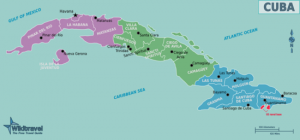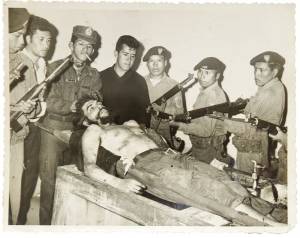At Seoul’s sprawling Dongdaemun Market, among the thousands of items on sale are T-shirts of Ernesto “Che” Guevara wearing a rakish black beret. Try however I might, I cannot understand why he inspires such fascination, indeed adoration. The cult of Che baffles me. Let’s take a look at the career of this polarizing man who liked seven-inch cigars. But I should warn you—what follows is history, not hagiography.
Revolution

In 1952, Guevara, a native of Argentina, dropped out of medical school and took a motorcycle trip through much of western South America. This excursion turned him into a fiery-eyed revolutionary, a latter-day Simon Bolivar. The remaining 15 years of his life would be devoted to fomenting revolution and combating “gringo imperialism,” notwithstanding the fact that he was partially of Irish descent and thus a gringo himself. Guevara was among 82 people (including Fidel and Raul Castro) who, in late November 1956, took a leaky yacht named Granma from Tuxpan, Mexico to a beach on Cuba’s southeastern coast. Their arrival was the beginning of the Cuban revolution, wherein Fulgencio Batista’s regime, in deep thrall to American gangsters like Meyer Lansky, Charles “Lucky” Luciano, Santo Trafficante, Jr. and Sam Giancana, was overthrown. Fortified by Soviet weaponry, they marched into Havana on New Year’s Day, 1959.
On August 8, 1960, Time magazine put him on its cover—flanked by Mao Zedong and Nikita Khrushchev—and called him “the brains of the revolution.” The New York Times was no less flattering. Guevara was invited to speak to the United Nations General Assembly in December 1964. He received a rapturous reception and took the opportunity to castigate the USA for its aggression against Vietnam, Cyprus, Puerto Rico, Cuba and several other so-called Latin American countries. He warned that “the wheel of history” was turning and woe to those who got in the way. By that time, he was Hero No. 1 to every left-leaning college student from New Haven to Berkeley. Guevara was long dead when Robert Redford’s The Motorcycle Diaries was released; it got a standing ovation at the 2004 Sundance Film Festival. Reviews were largely positive, the main exception being Roger Ebert of the Chicago Sun-Times. He opined that political correctness governed the thinking of most reviewers: “It’s not cool to be against Che Guevara.”
Natural-born killer
Only the staunchest conservative would claim that Cuba in the late 1950s had no need of revolution or at least major reform. Batista and the Mafia were bleeding it dry! Nor do I wish to assess all the pros and cons of that island nation since Castro took over almost 60 years ago. I will admit that the USA, its very large neighbor to the north, has done a lot to stifle its growth and development. Anyway, my focus is Guevara. Brutal and ruthless during the war (informers, deserters and spies usually got a .32-caliber  bullet in the head), he sure did not change after it had been won. Castro first appointed him commander of La Cabaña, the old Spanish military fortress in Havana. He was to consolidate victory by exacting “revolutionary justice.” The number of people who heard him exclaim, “¡a la paredón!” (“to the wall!”) is subject to debate. Five hundred? Some say double, triple or quadruple that. Guevara, an ardent admirer of Joseph Stalin, liked killing and was not afraid to pull the trigger. The tribunals at La Cabaña were supposed to be done carefully by two or three army officers, an assessor and a respected local citizen. As often as not, however, Guevara overrode the process. “To send men to the firing squad, judicial proof is unnecessary,” he once said. “These procedures are an archaic bourgeois detail.” The killing of men, women and children as young as 14 was not limited to La Cabaña. Indeed, the entire island became a killing field as death squads were sent out in all directions.
bullet in the head), he sure did not change after it had been won. Castro first appointed him commander of La Cabaña, the old Spanish military fortress in Havana. He was to consolidate victory by exacting “revolutionary justice.” The number of people who heard him exclaim, “¡a la paredón!” (“to the wall!”) is subject to debate. Five hundred? Some say double, triple or quadruple that. Guevara, an ardent admirer of Joseph Stalin, liked killing and was not afraid to pull the trigger. The tribunals at La Cabaña were supposed to be done carefully by two or three army officers, an assessor and a respected local citizen. As often as not, however, Guevara overrode the process. “To send men to the firing squad, judicial proof is unnecessary,” he once said. “These procedures are an archaic bourgeois detail.” The killing of men, women and children as young as 14 was not limited to La Cabaña. Indeed, the entire island became a killing field as death squads were sent out in all directions.
His role in defending Cuba from U.S.-backed forces in the Bay of Pigs invasion of April 1961 was not impressive. Guevara was fooled by a feint 350 miles away in Pinar del Rio and took several thousand troops there. He accidentally shot himself in the chin and did not bring his men to the Bay of Pigs until a day after the fighting was over.
The Russian connection
Guevara was deeply involved in—if not the architect of—Cuba’s secret police. He got advice from Francisco Ciutat, a man who had fled to the Soviet Union after the communists lost the Spanish Civil War. While there, Ciutat learned from a truly sinister chief of secret police: Lavrentiy Beria, who ran Stalin’s NKVD from 1938 to 1953.
What about the Cuban missile crisis of October 1962? Castro and Guevara were livid when the Soviets agreed to remove the nukes in exchange for a similar U.S. action in Turkey. “If the missiles had remained, we would have used them against the very heart of America, including New York City,” Guevara thundered. “We will march the path of victory even if it costs millions of atomic victims.”
Guevara was given wide latitude in restructuring the Cuban economy in the early 1960s. Peasants who resisted collectivization efforts were branded “counter-revolutionaries” and imprisoned or worse. Even his supporters concede that his policies were unsuccessful since he had no grasp of—or patience for—basic economic principles and made numerous impulsive, bone-headed decisions. (The effect of the U.S. embargo cannot be ignored here. John Maynard Keynes and Alan Greenspan together could not have made a success of the Cuban economy under those circumstances.)
Che the racist
He is assumed to have had all the left-wing bona fides, but maybe not. During his celebrated motorcycle journey of 1952, Guevara stopped in one of Caracas’ shanty towns, populated mostly by blacks. He said some things he came to regret—that blacks were “indolent and lazy,” wasted their money on booze and frivolity, and cared nothing for tomorrow. People of European descent, he averred, were the opposite. Batista, for all his faults, was of mixed race. He also came from a humble background, working as a child in the cane fields, later on the docks and railroads. Castro and Guevara were from the middle class or higher and never missed a meal; they went to boarding schools. Blacks and mulattos (to use an outdated term) must have wondered why they should follow these guys, one of whom wasn’t even Cuban. A taboo subject after the revolution was the fact that almost all the people who called the shots had light skin.
The self-styled revolutionary statesman also visited China, Russia, North Korea (he got on well with Kim Il-Sung), the United Arab Republic, Algeria, Egypt, Ghana, Benin, Guinea, Mali, Dahomey, Congo, Tanzania and Czechoslovakia. Rising antagonism—perhaps some old-fashioned ego problems—between Castro and Guevara as much as the desire to rid another country of American socio-economic oppression led him to try his hand in Bolivia.
Bolivian military says, “uh-uh”
Former Argentine President Juan Peron had warned him that waging guerilla warfare in that landlocked South American country was tantamount to suicide. But bent on overthrowing the Bolivian government, then headed by Rene Barrientos, and creating a socialist state, he refused to listen. Guevara entered La  Paz on November 3, 1966 with 25 Cubans and a handful of foreigners. About 30 Bolivians joined, and this motley crew called themselves the National Army for the Liberation of Bolivia (ELN). They carried out a couple of successful raids in Cordillera Province before Barrientos sent in U.S.-trained Bolivian Rangers. Nearly all the ELN soldiers were killed, but Guevara was taken alive. There are two vastly different versions of his behavior upon being seized and executed the next day, October 9, 1967: (1) bold and defiant, and (2) cowardly and begging for his life.
Paz on November 3, 1966 with 25 Cubans and a handful of foreigners. About 30 Bolivians joined, and this motley crew called themselves the National Army for the Liberation of Bolivia (ELN). They carried out a couple of successful raids in Cordillera Province before Barrientos sent in U.S.-trained Bolivian Rangers. Nearly all the ELN soldiers were killed, but Guevara was taken alive. There are two vastly different versions of his behavior upon being seized and executed the next day, October 9, 1967: (1) bold and defiant, and (2) cowardly and begging for his life.
Either way, Guevara was honored in Cuba as Castro ordered three days of public mourning. On October 18, a crowd estimated at 1,000,000 gathered in Havana’s Plaza de la Revolución to hear the Bearded One lament his comrade’s passing.

Add Comment